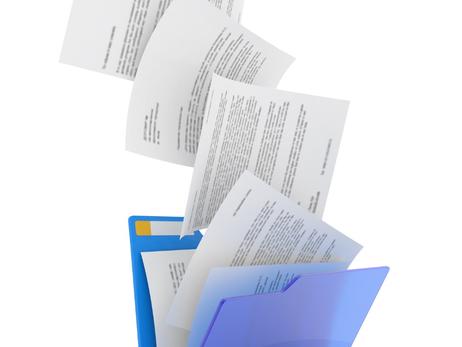Every application to private school goes through a thorough review process. The more competitive the school, the more exhaustive the review process becomes. So, the question we parents want to be answered is simply: how do we make sure our child's application gets to that final, all-important "Approved" stack of folders. Put another way, how do we ensure that our child's application has legs? (Having legs is an expression that speaks to the endurance of whatever is supposed to have legs.) With respect to admissions applications, the idea is to advance your child's application from one stage of the process to the next until finally, you achieve a positive outcome.
Here is what to do to ensure that your child's private school application has legs.
All required documentation has been submitted.
This sounds so simple, yet you would be amazed at how often an admissions application can founder right at the beginning of the review process. The staffer who reviews your child's application has a checklist of the required materials which must be in the folder. If something is missing, the folder goes into a stack for applications that have missing documents. It cannot normally advance to the next stage of the process for the reading and critical assessment of all those materials unless it is complete.
Ann Dolin sheds some light on the private school admissions process in this short video.
Each private school has its own admissions procedures and protocols. The more competition there is for places at a given school, the less likely errors and omissions in admissions applications will be tolerated if indeed they are tolerated at all.
Submit your completed application as early as you can. That applies both to online and paper applications. Murphy's Law will get you every time when you wait until the last minute to click the Submit button for an online application. At that exact moment, your system will freeze or your connection will drop. Count on it.
Therefore start several months before the applications deadline - assuming there is one - with the teacher and principal recommendations. Give those to the appropriate teachers together with stamps on the envelopes which will be used to mail those recommendations back to the school. Request transcripts from your child's current and previous schools as necessary.
The application exhibits strong academic qualifications.
Assuming that your application was submitted on time and with nothing missing, the next step is the reading of the file. Admissions staffers are an experienced lot. They know what they want to see in an application. Make sure that they see lots of what they are looking for.
Your application will have legs when it has test scores within the parameters the school has set. (Your educational consultant will be able to help you with what individual schools look for and with lots of other questions.)
Strong transcripts from your child's previous school should provide evidence that your child is prepared to undertake the academic workload that the school has scheduled. If there are deficiencies - no child is perfect, after all - it should be clear elsewhere in the application that you are aware of the deficiencies and have taken the appropriate steps to remediate those deficiencies.
If you are applying to a school that has special programs in place to remediate learning deficiencies, then the transcripts help the school establish a baseline from which to develop a program for your child.
Your application will have legs when it documents and supports your child's abilities. If your child is a super hockey player, make sure that you have the statistics and testimonials to support that claim. Assume nothing.
The application contains strong teacher and principal recommendations.
Most of the teacher recommendations which I had to write over the years were strong ones. The admissions staff can tell the difference between an enthusiastic recommendation and one which is written in a bland, non-committal language that doesn't say very much about the applicant. Remember: you will never know what a teacher has written when she writes a recommendation. Neither may you ask. Weak teacher recommendations will cripple an application's legs in a nano-second. Schools value the judgment of their peers. This part of the application is very important.
Teacher recommendations are much more proscribed than standard letters of reference. A letter of reference addresses the characteristics and achievements of the person for whom one is writing a letter of reference. The format is of the writer's choosing. He can selectively omit issues that he does not wish to address. In the private school admissions process teacher recommendations are narrowly focused on your child's accomplishments in specific subject areas - English or mathematics, for example- with the questions predetermined by the school's admissions staff.
How do you ensure success here? By encouraging your child to do her best. Teachers know when parents are encouraging and supportive of their children's learning. They also can tell the minute when a parent is disengaged from the process. Success in this aspect of your child's private school admissions application is not something that happens overnight. It is the result of years of consistent support for and supervision of your child's schoolwork.
The application has a high enthusiasm quotient.
Your application demonstrates that your child is eager to participate in class, on the sports field and in extracurricular activities. Document and support those claims with lists of achievements and participation in team and group activities. The energy and enthusiasm behind these achievements demonstrate a high enthusiasm quotient.
One of the goals most private schools have is to produce a well-rounded student. For example, this is what Latin School of Chicago has to say about the matter:
"creating an educational environment in which the pursuit of academic excellence and intellectual growth is complemented by a concern for the moral, physical, psychological and aesthetic development of each student"
You are prepared to be a partner with the school in your child's education.
Private schools pride themselves on creating that wonderful three-member partnership of the school, parent, and child. Make sure your Parents' Statement addresses that issue enthusiastically and sincerely. You have supported your child's education by creating a stable home that encourages responsibility and accountability. You consistently provide the enrichment your child needs in order to develop her natural love of learning.
Private schools also look to the long term. They hope that you will remain involved with the school long after your child has graduated. Satisfied parents are always a school's best advertisement.
Does your child's application have legs? If you follow the suggestions which I have laid out above, chances are it will. If you have taken an active interest in your child's education since she was born, then all the elements for a solid admissions application should be in place. The only obstacles left are deadlines and management of the admissions process of testing and school visits.
Questions? Contact us on Facebook. @privateschoolreview





















